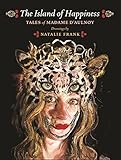The Island of Happiness : Tales of Madame d'Aulnoy / Madame d'Aulnoy; ed. by Natalie Frank.
Material type: TextPublisher: Princeton, NJ : Princeton University Press, [2021]Copyright date: ©2021Description: 1 online resource (240 p.) : 170 color illusContent type:
TextPublisher: Princeton, NJ : Princeton University Press, [2021]Copyright date: ©2021Description: 1 online resource (240 p.) : 170 color illusContent type: - 9780691180243
- 9780691213668
- LITERARY CRITICISM / General
- Bible of Filth
- Crossing the Line
- Dan Nadel
- Finette Cendron
- Grimm Tales
- Henri Matisse
- Homo Americanus
- La Chatte Blanche
- Le Chevalier Fortune
- Le Mouton
- Le Serpentin Vert
- L’Histoire de Mira
- L’Ille de la Felicite
- L’Oiseau Bleu
- Madison Museum of Contemporary Art
- Marcel Dzama
- Puppets, Pawns, and Prophets
- R. Crumb
- Raymond Petition
- Sower of Discord
- The Blue Bird
- The Book of Weirdo
- The Infidels
- The Ram
- The Tale of Mira
- artist book
- contemporary artist
- contemporary drawing
- fairy tale book
- fairy tale drawings
- feminist fairy tales
- pastel drawing
- pastel
- surreal drawing
- 843/.4 23
- PQ1711.A85 A2 2021
- online - DeGruyter
| Item type | Current library | Call number | URL | Status | Notes | Barcode | |
|---|---|---|---|---|---|---|---|
 eBook
eBook
|
Biblioteca "Angelicum" Pont. Univ. S.Tommaso d'Aquino Nuvola online | online - DeGruyter (Browse shelf(Opens below)) | Online access | Not for loan (Accesso limitato) | Accesso per gli utenti autorizzati / Access for authorized users | (dgr)9780691213668 |
Frontmatter -- Contents -- Introduction -- A Note on the Translation -- Drawing Mme d’Aulnoy -- Fairy Tales -- The Island of Happiness (L’Îlle de la Félicité) -- The Tale of Mira (L’Histoire de Mira) -- Finette Cendron (Finette Cendron) -- Belle-Belle, or the Chevalier Fortuné (Belle-Belle ou Le Chevalier Fortuné) -- The Blue Bird (L’Oiseau Bleu) -- The Ram (Le Mouton) -- The Green Serpent (Le Serpentin Vert) -- The White Cat (La Chatte Blanche)
restricted access online access with authorization star
http://purl.org/coar/access_right/c_16ec
An enchanting selection of Madame d’Aulnoy’s seventeenth-century French fairy tales, as interpreted by contemporary visual artist Natalie FrankMarie-Catherine Le Jumel de Barneville (1650–1705), also known as Madame d’Aulnoy, was a pioneer of the French literary fairy tale. Though d’Aulnoy’s work now rarely appears outside of anthologies, her books were notably popular during her lifetime, and she was in fact the author who coined the term “fairy tales” (conte de fées). Presenting eight of d’Aulnoy’s magical stories, The Island of Happiness juxtaposes poetic English translations with a wealth of original, contemporary drawings by Natalie Frank, one of today’s most outstanding visual artists. In this beautiful volume, classic narratives are interpreted and made anew through Frank’s feminist and surreal images.This feast of words and visuals presents worlds where women exercise their independence and push against rigid social rules. Fidelity and sincerity are valued over jealousy and greed, though not everything ends seamlessly. Selected tales include “Belle-Belle,” where an incompetent king has his kingdom restored to him through an androgynous heroine’s constancy. In “The Green Serpent,” a heroine falls in love with the eponymous snake, is punished by a wicked fairy, and endures trials to prove her worthiness. And in “The White Cat,” a young prince is dazzled by the astonishing powers of a feline. Jack Zipes’s informative introduction offers historical context, and Natalie Frank’s opening essay delves into her aesthetic approaches to d’Aulnoy’s characters.An inspired integration of art and text, The Island of Happiness is filled with seductive stories of transformation and enchantment.
Mode of access: Internet via World Wide Web.
In English.
Description based on online resource; title from PDF title page (publisher's Web site, viewed 25. Jun 2024)


